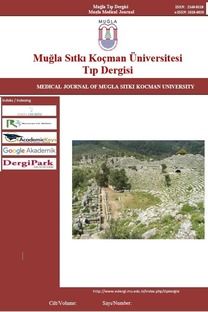Retrograd İntrarenal Cerrahi Deneyimimiz
Böbrek Taşı, Fleksibl Üreterorenoskop, Retrograd İntrarenal Cerrahi
Our Retrograde Intrarenal Surgery Experience
___
- 1. Tiselius HG, Ackermann D, Alken P, Buck C, Conort P, Gallucci M. Guidelines on urolithiasis. Eur Urol. 2001;40(4):362-71.
- 2. Preminger GM, Tiselius HG, Assimos DG, et al. 2007 guideline for the management of ureteral calculi. J Urol. 2007;178(6):2418-34.
- 3. Grasso M, Beaghler M, Loisides P. The case for primary endoscopic management of upper urinary tract calculi: II. Costandoutcomeassessment of 112 primary ureteral calculi. Urology. 1995;45(3):372-6.
- 4. Breda A, Ogunyemi O, Leppert JT, Schulam PG. Flexible Ureteroscopy and Laser Lithotripsy for Multiple Unilateral Intrarenal Stones. Eur Urol. 2009;55(5):1190-7.
- 5. Galvin DJ, Pearle MS. The contemporary management of renal and ureteric calculi. BJU Int. 2006;98(6):1283-8.
- 6. Unsal A, Resorlu B, Kara C, Bozkurt OF, Ozyuvali E. Safety and efficacy of percutaneous nephrolithotomy in infants, preschool age and older children with different sizes of ınstruments. Urology. 2010;76(1):247-52.
- 7. Kara C, Resorlu B, Bayindir M, Unsal A. A randomizedcomparison of totally tubeless and standard comparison of percutaneous nephrolithotomy in elderly patients. Urology. 2010;76(2):289-93.
- 8. Huffman JL, Bagley DH, Lyon ES. Extending cystoscopic techniques into the ureter and renal pelvis. Experience with ureteroscopy and pyeloscopy. JAMA. 1983;250(15):2002-5.
- 9. Cimentepe E, Unsal A, Saglam R, Balbay MD. Comparison of clinical outcome of extra corporeal shock wave lithotripsy in patients with radiopaque v radiolucent ureteral calculi. J Endourol. 2003;17(10):863-5.
- 10. Resorlu B, Senocak C, Cicekbilek I, Unsal A. Percutaneous nephrolithotomy versus retrogradeintrarenal surgery for lower pole renal Stones with a dia meter of 10 to 20 milimeters. 28thWorld Congress of Endourologyand SWL, Chicago, 2010,p.220.
- 11. Wong MY. Flexible ureteroscopy is the ideal choicetomanage a 1.5 cm diameterlower-polestone. J Endourol. 2008;22(9):1845-6.
- 12. Fuchs GJ, Fuchs AM. Flexibleendoscopy of theupperuri¬narytract. A new minimally invasive method for diagnosis and treatment. Der Urologe Ausg A. 1990;29(6):313-20.
- 13. Preminger GM. Management of lower pole renal calculi: shock wave lithotripsy versus percutaneous nephrolithot¬omy versus flexible ureteroscopy. Urol Res. 2006;34(2):108-11.
- 14. Fabrizio MD, Behari A, Bagley DH. Ureteroscopic management of intra renal calculi. J Urology.1998;159(4):1139-43.
- 15. Papatsoris A, Sarica K. Flexible ureterorenoscopic management of upper tract pathologies. Urol Res. 2012;40(6):639-46.
- 16. Watterson JD, Girvan AR, Cook AJ, et al. Safety and ef-ficacy of holmium: YAG laser lithotripsy in patients with bleeding diatheses. J Urology. 2002;168(2):442-5.
- 17. Harmon WJ, Sershon PD, Blute ML, et al. Ureteroscopy: current practice and long-term complications. J Urology. 1997;157(1):28-32.
- 18. Singal RK, Razvi HA, Denstedt JD. Secondary ureteros-copy: results and management strategy at a referral center. J Urology. 1998;159(1):52-5.
- 19. Delvecchio FC, Auge BK, Brizuela RM, et al. Assessment of stricture formation with the ureteral Access sheath. Urol¬ogy. 2003;61(3):518-22.
- ISSN: 2148-8118
- Yayın Aralığı: 3
- Başlangıç: 2014
- Yayıncı: Muğla Sıtkı Koçman Üniversitesi
Lenfoid Stroma İlişkili Gastrik Karsinom (Gastrik Meduller Karsinom): Nadir Bir Olgu Sunumu
Mustafa DEGIRMENCI, Bulent CALIK, Sulen SARIOGLU, Ozgul SAGOL, Sumeyye EKMEKCI, Yelda DERE
Gastric Carcinoma With Lymphoid Stroma (Gastric Medullary Carcinoma): A Rare Case Report
Sümeyye EKMEKÇİ, Yelda DERE, Mustafa DEĞİRMENCİ, Bülent ÇALIK, Özgül SAĞOL, Sülen SARIOĞLU
GASTRIC CARCINOMA WITH LYMPHOID STROMA (GASTRIC MEDULLARY CARCINOMA): RARE CASE REPORT
Sümeyye EKMEKCI, Yelda DERE, Mustafa DEĞİRMENCİ, Bülent ÇALIK, Özgül SAĞOL, Sulen SARIOGLU
Retrograd İntrarenal Cerrahi Deneyimimiz
İlker AKARKEN, Ömer ERDOĞAN, Hasan DELİKTAŞ, Hayrettin ŞAHİN
Gülşen DOĞAN DURDAĞ, Hakan SATIROĞLU, Batuhan ÖZMEN, Ruşen AYTAÇ, Cem ATABEKOĞLU, Bülent BERKER, Murat SÖNMEZER
Ender SİR, Mehmet Emin ORHAN, Sami EKSERT, Gökhan ÖZKAN, Tarık PURTULOĞLU, Abdülkadir ATIM, Bülent ATİK, Ercan KURT
Engin KARAKUZU, Serkan ERGÖZEN
Canan GÜRSOY, Eylem YAŞAR, Gizem EYÜBOĞLU, Semra GÜMÜŞ DEMİRBİLEK
Nadir Bir Olgu Sunumu: Rekürrent İnguinal Herni Şüphesi Yaratan Skrotal Kitle
